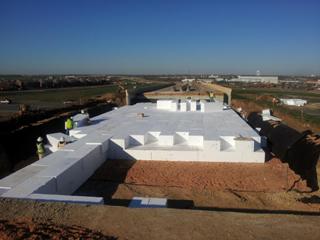Jun 12 2015
A research team at The University of Texas at Arlington is using giant lightweight geofoam blocks to bolster the earth beneath roads and bridges and slow down the settling of roadways and bridges.
 Geofoam blocks being installed underneath a North Texas highway will ensure stability for a longer period of time than traditional construction. Credit:Courtesy of UT Arlington
Geofoam blocks being installed underneath a North Texas highway will ensure stability for a longer period of time than traditional construction. Credit:Courtesy of UT Arlington
Anand Puppala, UT Arlington associate dean for research in the College of Engineering and distinguished scholar professor in the Civil Engineering Department, said that the majority of the world's largest cities, often built in areas near water bodies, have soft and compressible soils. He said a good number of the 52,000 bridges in Texas have bump problems on entry due to settling of the soil under the pavement slabs.
A new $336,000 implementation grant from the Texas Department of Transportation received by UTA's Sustainable and Resilient Civil Infrastructure Center will allow Puppala and his co-researcher, assistant professor Xinbao Yu, to test the use of the geofoam blocks to ease the problem. The blocks measure about 6.5 feet by 2.5 feet by 2.5 feet.
'If you place something heavy, like a road or a bridge, on soft soil, it will stress the underlying soil which gets compressed with time,' Puppala said. 'Geofoam blocks cut down on sediment, can be stacked, and do not place stress on the soil, so structures are safer and more stable. They are also environmentally safe and designed in such a way that they do not degrade.'
Puppala, Yu and their team have installed the blocks near a bridge at U.S. Highway 67 and State Highway 174 in Johnson County to attempt to slow serious settling at the bridge entrance. This area has settled 17 inches since 1995 due to heavy truck traffic loads, which was close to one inch per year. The UTA team replaced an embankment near the bridge with geofoam blocks in 2012. In the three years since the installation, the team has measured a total of less than one inch of settlement.
The new implementation grant will allow more monitoring to make sure the blocks continue to work.
'Several methods were used previously to try to stop the settling, but none worked,' Puppala said. 'We are encouraged by the results of using the geofoam so far. We are discussing using this material at other bridge sites as well.'
To install the blocks, crews dig out the area where they are going to be used, stack the blocks on top of each other to achieve the necessary grade and road width, then cover them with soil, which is then packed down before pavement is laid on top of the stack.
'Dr. Puppala and Dr. Yu's work show how innovation can help the world,' said Khosrow Behbehani, UTA dean of engineering. 'Better infrastructure helps people get to and from work and necessary services, allows commerce to flourish, and saves taxpayer money in the long term.'